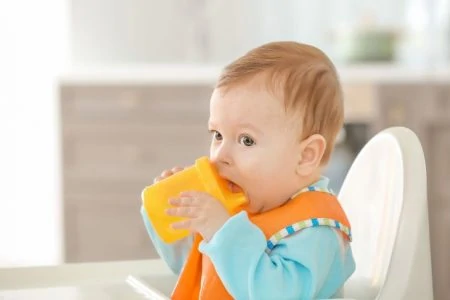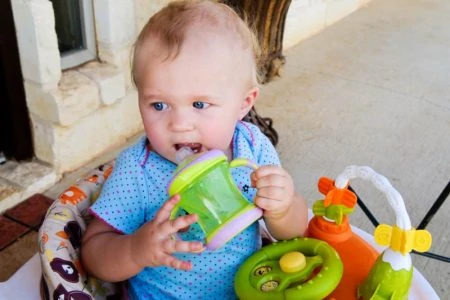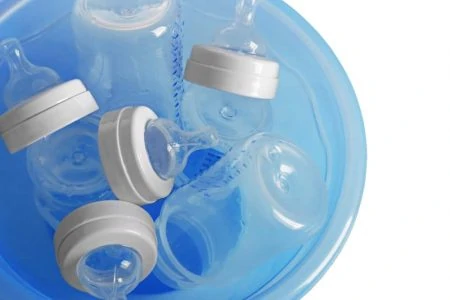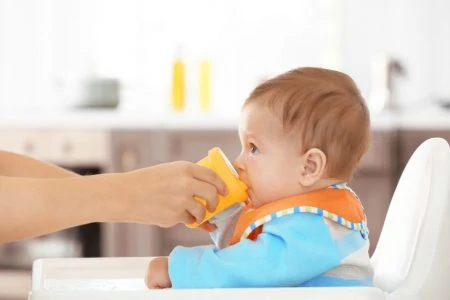However, these handy vessels carry hidden risks, ranging from mold growth to long-term dental issues. We aren’t saying you have to banish them forever, but knowing the facts ensures the sippy you hand your toddler is as safe as possible.
Key Takeaways
- Sippy cups can harbor mold and bacteria if not cleaned meticulously.
- Improper use may lead to mouth injuries, dental issues, or speech delays.
- Toddlers should always be seated while drinking to prevent falls.
- Limit usage to mealtimes; avoid letting children carry cups all day.
Do Toddlers Need to Use a Sippy Cup?
Technically, no. A sippy cup isn’t a developmental necessity, but it is a massive convenience for parents. Experts recommend you wean your child off bottles by 18 months; wait too long, and that emotional attachment becomes much harder to break (1).
However, transitioning a young toddler straight to open cups guarantees spills. While sippy cups aren’t required for your child’s growth, they preserve your sanity and your clean floors.
Risks Associated with Sippy Cup Use
Sippy cups don’t look dangerous. They aren’t obvious hazards like an unguarded flight of stairs without a baby gate. Yet, there are subtle risks involved with their daily use.
Here are the main concerns:
- Mold growth: Moisture from saliva combined with food particles trapped in valves, straws, or spouts creates a breeding ground for bacteria. Complex cups are hard to scrub effectively. If you don’t clean your sippy cups perfectly after every use, your child could ingest mold.
- Mouth injury: Emergency rooms see thousands of children yearly for mouth injuries related to bottles and sippy cups (2). These accidents usually happen when a child trips or falls while walking around with the spout in their mouth.
- Improper oral development: Constant sucking on a rigid spout affects how a child’s oral cavity grows (3). Unlike a breast or soft bottle nipple, hard plastic doesn’t conform to the mouth. Overuse can impact speech development, lead to expensive orthodontia later, and even affect facial structure.
- Tooth decay and obesity: Sippy cups are spill-proof, so parents often let kids keep them all day. This constant access creates bad habits. If the cup holds juice or milk, the sugars coat the teeth for hours, leading to “bottle rot” and cavities. It also teaches children to graze on drinks for comfort rather than drinking only to quench thirst.
Sippy Cup Safety Tips
You don’t have to throw every cup away. Just follow these guidelines to minimize risks:
1. Always Clean Them Properly
Mold hides in tight spaces. To prevent bacteria buildup, follow a strict cleaning routine:
- Rinse the cup immediately after your child finishes drinking.
- Disassemble every single part, especially the rubber valves and gaskets.
- Soak parts in hot, soapy water for 15 minutes to loosen dried milk or pulp.
- Scrub all crevices with a small brush and hot water.
- Let every piece air dry completely before re-assembling.
2. Don’t Let Your Child Walk While Drinking
It is tempting to let your toddler roam with a drink, but this is a primary cause of oral trauma. Implement a “sit down to drink” rule. If they are thirsty, they sit at the table or in a high chair. This simple habit drastically reduces trips to the ER.
3. Choose Straws Over Spouts
Hard spouts are durable, but they pose the biggest fall hazard and promote an immature swallowing pattern.
Opt for cups with silicone straws or rimless designs (like 360 cups). Straws encourage better oral motor skills and tongue positioning, which helps with speech development. They are slightly harder to clean, but they are much better for your child’s mouth.
4. Keep Cups at the Table
Limit sippy cup use to scheduled meals and snacks. This teaches your child that calories come from food times, not from carrying a sugary drink around the playroom.
This boundary protects their teeth from constant acid attacks and sugar exposure. It also prevents appetite suppression; kids who fill up on milk all day often refuse to eat their dinner.
5. Skip Straight to a Regular Cup
If you have the patience, bypass the sippy phase entirely. Offer small amounts of water in an open cup. You will have more spills initially, but your child will master cup handling faster. This avoids the “crutch” of a spill-proof valve and promotes healthy swallowing mechanics immediately.
You Could Try This
6. Wean by Age Three
If you use sippy cups, have an exit strategy. Aim to wean from the sippy cup completely by their third birthday. By this age, children have the motor skills to handle open cups or regular straw cups without spill-proof valves.
Set a deadline. Without a goal, it is too easy to rely on the convenience of spill-proof cups well into elementary school.
7. Treat Them Like Travel Mugs
Think of sippy cups like your own travel coffee mug. You use it in the car or on a walk, but you wouldn’t use it at the dinner table.
Adopt this mindset for your toddler. Use the sippy cup for car rides, stroller walks, or protecting the new sofa. At the kitchen table, switch to open cups or straw cups. This balanced approach minimizes the risks while keeping your life manageable.










